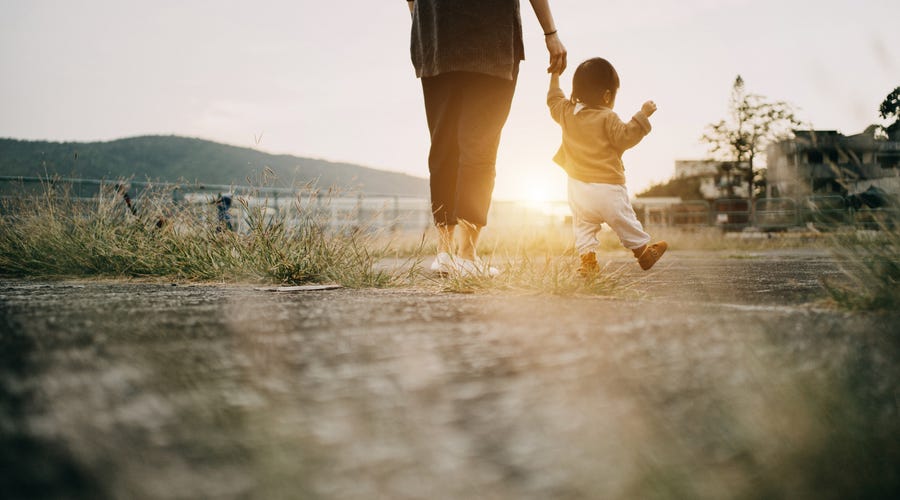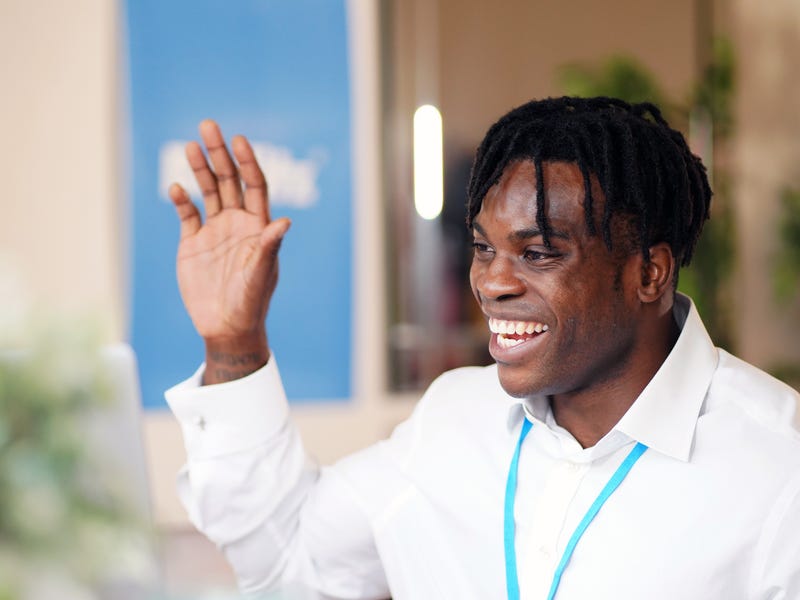
102 incredibly useful body parts in German that you need to know
Author: Marie Schmoll
In all languages, we use figurative speech to describe unknown or abstract concepts with something we know well, something close and tangible, and there is nothing in this world we know as well as our own bodies.
That’s why figurative speech so often borrows words related to the body, and you can’t escape learning body-related terms when learning a new language.
If you’re learning German online, you’ll want to know how to say “face” or “feet” in German, too. So we collected all the important body parts in German for you - top to bottom and inside out, plus some fun idioms.
Once you know those, you can use them to talk about so much more than just the physical body!
Learn the head and body parts in German with this free poster.
Why learn about German body parts?
Be prepared for medical emergencies
Language barriers are never fun, but they can actually become dangerous if you find yourself in a foreign country and have troubles communicating through a medical emergency.
Knowing how to describe your body in German and specifically where it might hurt or where you suspect a medical condition that needs attention is helpful and potentially even life-saving.
Understand all figurative speech
In both English and German, a word you’re about to remember is on (the tip of) your tongue (in German: “auf der Zunge liegen)”, but other idioms vary.
While you’re picking someone’s brain in English, you’re actually asking them “holes into their stomach” in German (“Löcher in den Bauch fragen”). So many idioms are related to parts of the body. To understand them, you’ll need body-related vocabulary.
Give a compliment
Until we know someone well enough to compliment their personality, an easy way to compliment someone is by knowing some basic body-related vocabulary. “You have beautiful eyes” is “Du hast schöne Augen” and “I like your hair” is “Ich mag deine Haare”. Compliments are often appreciated. Just don’t overdo it. Be nice.

Learn the head and body parts in German with this free poster
For those of you who don’t like traditional study methods, we get you. Print this poster and stick it to your fridge for a great way to learn the parts of the body that don’t involve long hours at the library. I'm ready!
How to say “body” in German
The German word for body has one of those famous Umlaut-letters: The Ö, which is somewhere between an “oh” and an “ey”.
Other than that, it’s pretty straightforward, cöre - pah [ˈkœʁ pɐ]. If you’re still unsure about how to pronounce any of the letters, you can always reference our guide on how to pronounce each letter of the German alphabet.
Head in German
Head in German is “Kopf” [kɔp͡f]. It’s pronounced exactly as you’d expect, like the English “cop” directly followed by an “f” - no surprises there.
It gets slightly more complex when you encounter words like “Zähne” (teeth) or “Nasenloch” (nostril) but don’t worry. We’re here to help.
Face parts in German
Let’s begin with the head and face, your center of emotional expression. This is where smiles are born, and words are formed - a great place to start learning parts of the body in German.
| English | German body part | German pronunciation |
|---|---|---|
| Head | Kopf | [kɔp͡f] |
| Face | Gesicht | [ɡəˈzɪçt] |
| Ears | Ohren | [ˈoːɐ̯n] |
| Eyes | Augen | [ˈaʊ̯ɡn̩] |
| Nose | Nase | [ˈnaːzə] |
| Chin | Kinn | [kɪn] |
| Cheeks | Wangen | [ˈvaŋən] |
| Forehead | Stirn | [ʃtɪʁn] |
| Jaw | Kiefer | [ˈkiːfɐ] |
| Eyebrows | Augenbrauen | [ˈaʊ̯ɡn̩ˌbʁaʊ̯ən] |
| Eyelashes | Wimpern | [ˈvɪmpɐn] |
| Temple | Schläfe | [ˈʃlɛːfə] |
| Nostril | Nasenloch | [ˈnaːzn̩ˌlɔx] |
| Lips | Lippen | [ˈlɪpm̩] |
| Mouth | Mund | [mʊnt] |
| Teeth, Tooth | Zähne, Zahn | [ˈt͡sɛːnə], [t͡saːn] |
| Tongue | Zunge | [ˈt͡sʊŋə] |
| Hair | Haar | [haːɐ̯] |
| Neck | Hals | [hals] |
Other body parts in German
Now we’ll make our way further down from our scalp over our bellybutton to our toes.

| English | Body part in German | Pronunciation |
|---|---|---|
| Scalp | Kopfhaut | [ˈkɔp͡fˌhaʊ̯t] |
| Throat | Kehle | [ˈkeːlə] |
| Shoulders | Schultern | [ˈʃʊltɐn] |
| Arms | Arme | [ˈaʁmə] |
| Left arm | Linker Arm | [lɪŋkɐ aʁm] |
| Right arm | Rechter Arm | [ˈʁɛçtɐ aʁm] |
| Armpits | Achseln | [ˈaksəln] |
| Torso | Oberkörper | [ˈoːbɐˌkœʁpɐ] |
| Collarbone | Schlüsselbein | [ˈʃlʏsl̩ˌbaɪ̯nəs] |
| Back of the neck | Nacken | [ˈnakn] |
| Back | Rücken | [ˈʁʏkn̩] |
| Upper back | Oberer Rücken | [ˈoːbəʁɐ ˈʁʏkn̩] |
| Lower back | Unterer Rücken | [ˈʊntəʁɐ ˈʁʏkn̩] |
| Buttom | Hintern, Po | [ˈhɪntɐn], [pɔ] |
| Buttocks | Pobacken | [ˈpoːˌbakn̩] |
| Chest | Brust | [bʁʊst] |
| Breast nipple | Brustwarze | [ˈbʁʊstˌvaʁt͡sə] |
| Waist | Taille | [ˈtaljə] |
| Abdomen | Bauch | [baʊ̯x] |
| Bellybutton | Bauchnabel | [ˈbaʊ̯xˌnaːbl̩] |
| Hip | Hüfte | [ˈhʏftə] |
| Hands | Hände | [ˈhɛndə] |
| Left hand | Linke Hand | [ˈlɪŋkə hant] |
| Right hand | Rechte Hand | [ˈʁɛçtə hant] |
| Flat hand | Flache Hand | [ˈflaxə hant] |
| Fist | Faust | [faʊ̯st] |
| Knuckle | Fingerknöchel | [ˈfɪŋɐˌknœçl̩] |
| Finger | Finger | [ˈfɪŋɐ] |
| Finger tips | Fingerspitzen | [ˈfɪŋɐˌʃpɪt͡sən] |
| Fingernail | Fingernagel | [ˈfɪŋɐˌnaːɡl̩] |
| Palm | Handfläche | [ˈhantˌflɛçə] |
| Thumb | Daumen | [ˈdaʊ̯mən] |
| Index finger | Zeigefinger | [ˈt͡saɪ̯ɡəˌfɪŋɐ] |
| Middle finger | Mittelfinger | [ˈmɪtl̩ˌfɪŋɐ] |
| Ringfinger | Ringfinger | [ˈʁɪŋˌfɪŋɐ] |
| Little finger | Kleiner Finger | [ˈklaɪ̯nɐ ˈfɪŋɐ] |
| Legs | Beine | [ˈbaɪ̯nə] |
| Left leg | Linkes Bein | [ˈlɪŋkəs baɪ̯n] |
| Right leg | Rechtes Bein | [ˈʁɛçtəs baɪ̯n] |
| Knee | Knie | [kniː] |
| Kneecap | Kniescheibe | [ˈkniːˌʃaɪ̯bə] |
| Knee pit | Kniekehle | [ˈkniːˌkeːlə] |
| Calf | Wade | [ˈvaːdə] |
| Shin | Schienbein | [ʃiːnbaɪ̯n] |
| Ankle | Knöchel | [ˈknœçl̩] |
| Feet | Füße | [ˈfyːsə] |
| Left foot | Linker Fuß | [ˈlɪŋkɐ fuːs] |
| Right foot | Rechter Fuß | [ˈʁɛçtɐ fuːs] |
| Heel | Hacke | [ˈhakə] |
| Toe | Zeh | [t͡seː] |
| Big toe | Großer Zeh, Großer Onkel | [ˈɡʁoːsɐ t͡seː], [ˈɡʁoːsɐ ˈɔŋkl̩] |
| Little toe | Kleiner Zeh | [ˈklaɪ̯nɐ [t͡seː] |
| Toe nails | Zehennägel | [ˈt͡seːənˌnɛːɡl̩] |
Inside body parts in German
We all know it’s what’s inside that matters most. So we don’t want you to miss out on the inner body parts in German. Some of these have interesting names, not all of them that appetizing.
In German, tonsils have the same name as almonds (Mandeln) and the placenta is called the “mother cake” (Mutterkuchen) after its Latin origin. Guten Appetit!
| English | Body part in German | Pronunciation |
|---|---|---|
| Brain | Gehirn | [ɡəˈhɪʁn] |
| Cerebellum | Kleinhirn | [ˈklaɪ̯nˌhɪʁn] |
| Brainstem | Stammhirn | [ʃtamhɪʁn] |
| Heart | Herz | [hɛʁt͡s] |
| Lungs | Lungen | [ˈlʊŋən] |
| Liver | Leber | [ˈleːbɐ] |
| Bladder | Blase | [ˈblaːzə] |
| Kidneys | Nieren | [ˈniːʁən] |
| Stomach | Magen | [ˈmaːɡn̩] |
| Intestines | Gedärme | [ɡəˈdɛʁmə] |
| Appendix | Blinddarm | [ˈblɪntˌdaʁm] |
| Bones | Knochen | [ˈknɔxn̩] |
| Bone marrow | Knochenmark | [ˈknɔxn̩ˌmaʁk] |
| Bronchi | Bronchien | [ˈbʁɔnçi̯ən] |
| Tonsils | Mandeln | [ˈmandln] |
| Larynx | Kehlkopf | [ˈkeːlkɔp͡f] |
| Diaphragm | Membran | [mɛmˈbʁaːn] |
| Gallbladder | Gallenblase | [ˈɡalənˌblaːzə] |
| Genitals | Genitalien, Geschlechtsorgane | [ɡeniˈtaːli̯ən], [ɡəˈʃlɛçt͡sʔɔʁˌɡaːnə] |
| Ovaries | Eierstöcke | [ˈaɪ̯ɐˌʃtœkə] |
| Uterus | Uterus | [ˈuːtəʁʊs] |
| Placenta | Plazenta, Mutterkuchen | [plaˈt͡sɛnta], [ˈmʊtɐˌkuːxn̩] |
| Prostate | Prostata | [ˈpʁɔstata] |
| Lymph Nodes | Lymphknoten | [ˈlʏmfˌknoːtn̩] |
| Pancreas | Pankreas, Bauchspeicheldrüse | [ˈpankʁeas], [ˈbaʊ̯xʃpaɪ̯çl̩ˌdʁyːzə] |
| Pharynx | Rachen | [ˈʁaxn̩] |
| Spinal cord | Rückenmark | [ˈʁʏkn̩ˌmaʁk] |
| Spleen | Milz | [mɪlt͡s] |
| Thyroid | Schilddrüse | [ˈʃɪltˌdʁyːzə] |
| Capillaries | Kapillaren | [kapɪˈlaːʁən] |
Body parts in German song
One fun way to learn the most important body parts in German is with songs. We found three great options for you.
Kopf, Schulter, Knie and Fuß | Monster Mash | German Poem For Children | Kids Poem | Toffee TV
Join these three German monsters in their workout, learn the lyrics as they exercise and see if you can keep up with their pace. You’ll soon be as fit in German as they are in tapping and squatting.
Kopf und Schultern, Knie und Fuß - Kinderlieder zum Mitsingen | Sing Kinderlieder
What makes this video especially helpful is that it starts with the German version of the song and then introduces the same song in English. The second time you listen to it, you will already have the English lyrics memorized as they are that easy and it will be easy for you to understand the German part.
Körperteil Blues (Offizielles Tanzvideo) - Lichterkinder | Kinderlieder | Bewegungslieder
These kids sing and dance to the Body Part Blues, explaining not only the body parts but also what they do, so you’ll learn the corresponding verbs as well: “Wir sehen mit den Augen und riechen mit der Nase”. It’s true, we see with our eyes and smell with our nose” and with this song, we’ll soon be dancing with our whole body as it’s surprisingly catchy!
Body-related German words, expressions and sayings
There are many more body-related words than just the body parts. Some are the same as in English, while others vary but you’ll see that both languages like to use the body to describe abstract concepts like character traits or mental states.
| English | German | Pronunciation | Literal Translation |
|---|---|---|---|
| Nobody | Niemand | [ˈniːmant] | - |
| Somebody | Jemand | [ˈjeːmant] | - |
| Everybody | Jeder | [ˈjeːdɐ] | - |
| Break a leg! | Hals- und Beinbruch! | [hals ʔʊnt ˈbaɪ̯nbʁʊx] | Break a neck and a leg! |
| It’s on the tip of my tongue | Es liegt mir auf der Zunge | [ɛs liːkt miːɐ̯ aʊ̯f deːɐ̯ ˈt͡sʊŋə] | It lies on my tongue |
| To be all ears | Ganz Ohr sein | [ɡant͡s oːɐ̯ zaɪ̯n] | To be all ear |
| To swear by your life | Stein und Bein schwören | [ˈʃtaɪ̯n ʊnt ˈbaɪ̯n ˈʃvøːʁən] | To swear stone and leg |
| To pick someone’s brain | Jemandem Löcher in den Bauch fragen | [ˈjeːmandm̩ ˈlœçɐ ɪn deːn ˈbaʊ̯x ˈfʁaːɡn̩] | To ask someone holes into their stomach |
| To have butterflies in the stomach | Schmetterlinge im Bauch haben | [ˈʃmɛtɐlɪŋə ɪm baʊ̯x ˈhaːbn̩] | To have butterflies in the stomach |
| To be aggressively confrontational | Haare auf den Zähnen haben | [ˈhaːʁə aʊ̯f deːn ˈt͡sɛːnən ˈhaːbn̩] | To have hair one one’s teeth |
| To be on edge | Auf dem Zahnfleisch gehen | [aʊ̯f deːm ˈt͡saːnflaɪ̯ʃ ˈɡeːən] | To walk on the gums |
| To get to someone | Jemandem an die Nieren gehen | [ˈjeːmandm̩ an diː ˈniːʁən ˈɡeːən] | To get to someone’s kidneys |
| To cheat someone | Jemanden übers Ohr hauen | [ˈjeːmandn ˈyːbɐs oːɐ̯ ˈhaʊ̯ən] | To punch someone above the ear |
| Body language | Körpersprache | [ˈkœʁpɐˌʃpʁaːxə] | Bodylanguage |
| From head to toe | Von Kopf bis Fuß | [fɔn kɔp͡f bɪs fuːs] | From head to foot |
You can find more fun German expressions and slang in this comprehensive article here.
Tips for learning German body parts

Make it a game
Games are always the most fun ways to learn something new. Find a partner and start by tapping a body part of yours. Tap your nose, for example and your partner has to say the German word “Nase”. Whoever runs out of the correct vocabularies first, loses.
Or try writing body parts on your body with skin-friendly ink.
Try the English word
Many German words related to the body are very similar to the English words, even more so than in other vocabulary groups: “Mund” and ”Mouth”, “Lippen” and “Lips”, “Nase” and “Nose”, “Fuß” and “Foot”, “Knie” and “Knee”.
When you’re not sure about the German word, try saying the English word with a bit of a German touch, and more often than not, you will get away with it when it comes to body parts.
Use sports
One area where you will hear people talk about body parts is in sports. Watch a game of soccer or a boxing match with German commentary and listen for the body parts.
A player touched the ball with his elbow? The boxer injured his ankle? Find a game you enjoy, kick back, listen while you learn some new words.
Our most important tool for language learning
Our body is our most important tool in everything we do - including language learning and speaking. It’s the way we experience the world and what we use when we run out of words. As a language learner, you’ll know that our faces often say more than a thousand words and we can use our hands to count in German, to point, and to show a whole variety of hand gestures, from a thumbs up to a wavy ‘so-so’.
Bear in mind that those, too, vary from country to country, but in general, the body is our number one tool for language learning and it helps to know all the body parts when using it.



